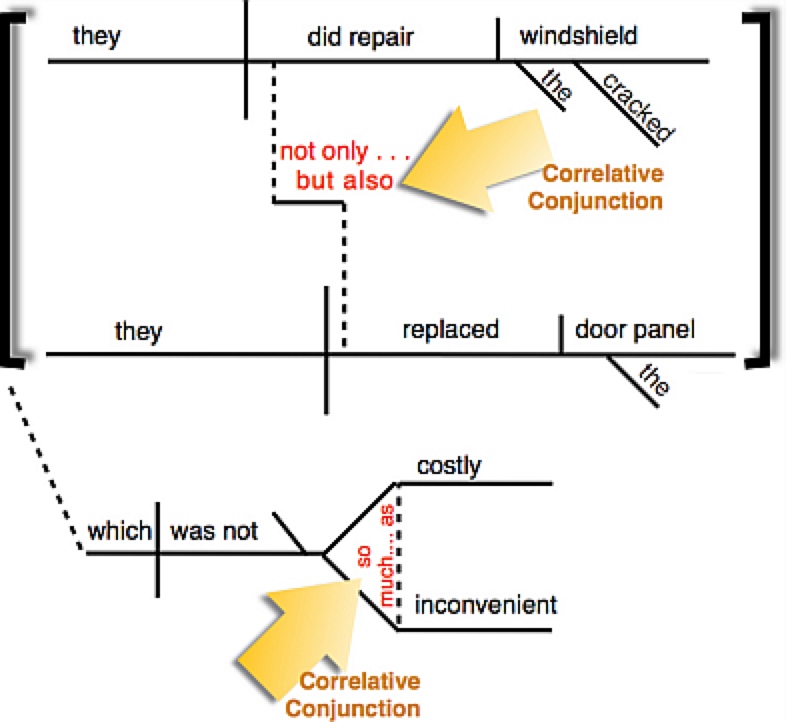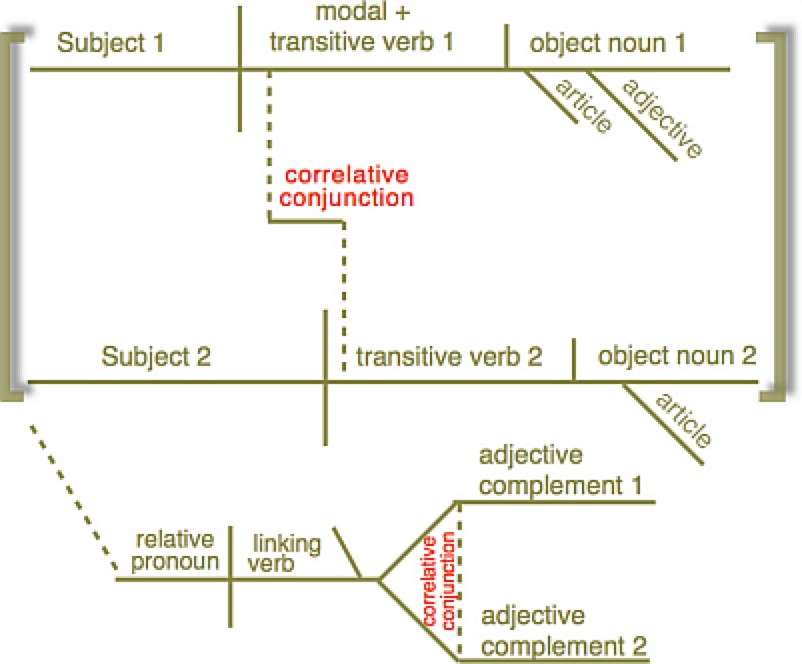
Karl J Sherlock
Associate Professor, English
Email: karl.sherlock@gcccd.edu
Phone: 619-644-7871

Some conjunctions combine with other words to form what are called correlative conjunctions.
They always occur as a pair of phrases, joining various sentence elements that should be treated as grammatically equal and given parallel structure. The most familiar of these is the "either - or (neither -nor)" phrase because it includes common coordinating conjunctions as well.
Other correlative conjunctions, however, are frequently relied upon to coordinate complex ideas with parallel structure:
Combinations of other comparative adjectives can be used like correlative conjunctions to identical effect. Such adjectives include: more, less, fewer, further, farther, lower, higher, greater, etc.
Diagramming a correlative conjunction is really no different from diagramming a coordinating conjunction. It all depends on whether they are being used to juxtapose two or more clauses, or two or more compound elements in a sentence.
Note: Ordinarily, the Relative Pronoun “which” would take just one clause as its antecedent. In this sentence, it takes the two parallel clauses juxtaposed by the correlative conjunctions. This is shown in the diagram with the use of large brackets.
Diagramming a sentence using correlative conjunctions allows you to see where parallel structure is needed, because both halves of the correlative conjunction must use the same parts of speech in the same order if they are to present a balanced correlation.


In this version of the example, "[they did] repair the cracked windshield" is not parallel in structure with "the door panel," for the obvious reason that one is a clause and the other is a noun phrase. This can be resolved either by building the noun phrase into a full clause, or by moving the correlative conjunction so that it correlates two noun phrases that are parallel to each other:
Keep in mind that the point of a correlative conjunction is to make things simpler and logical. Juxtaposing two or more words, phrases or clauses can become confusing, but correlating helps to streamline the process. There’s more than one way to skin a cat, though. (Please forgive the gruesome platitude!) In many cases, writers can choose to expand or contract the correlated parts, and even deconstruct the correlative conjunctions. After all, words such as “not only” and “also” are adverbs in their own right, and they can be treated as such. Here are two alternative versions of the above-mentioned exampled, with diagrams to show you how the correlative conjunctions have been deconstructed. In this first alternative version, the correlative conjunctions “not only…but also” and “…so much as…” are deconstructed.
The first correlative conjunction, “not only…but also,” becomes the coordinating conjunction “but,” and the second correlative conjunction, “…so much as…” becomes a comparative subordinating conjunction “as.” The result is a compound-complex sentence (a sentence with two or more independent clauses and at least one subordinate clause). Take note of two things: 1) where the adverbs from the correlative conjunctions (“not,” “only,” “also,” “so,” “much”) end up on the diagram; and 2) how the relative clause containing “as” has been expanded into two, restoring the subject pronoun and linking verb to “it was inconvenient.”

In this next alternate version, the correlative conjunction “not only…but also” is broken up to create one independent clause with compound predicate verbs, but the correlative conjunction “…so much as…” is left as is, correlating two adjective complements. (Remember: “was” is a linking verb.)

Correlative conjunctions are not the only circumstances in which parallel structure should be a concern. Parallel structure is also required in comparisons and in a series of phrases. The lesson here is that, if you ever become confused about parallelism and correlative conjunctions, try to express the same idea in a few different ways. Deconstruct the correlative conjunction into its regular conjunctions and adverbs. Expand or reduce the correlated elements into other parallel arrangements to see what sounds clearest and most logical. Just remember that, in all cases, parallel structure means two or more elements look identical to each other in grammar, syntax, and parts of speech.
Karl J Sherlock
Associate Professor, English
Email: karl.sherlock@gcccd.edu
Phone: 619-644-7871

8800 Grossmont College Drive
El Cajon, California 92020
619-644-7000
Accessibility
Social Media Accounts